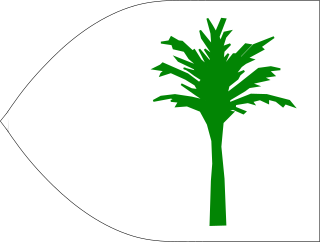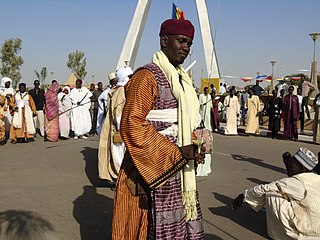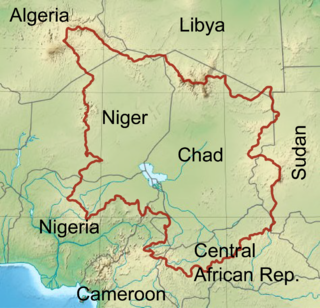Related Research Articles

The Kanem–Bornu Empire existed in areas which are now part of Niger, Cameroon, Chad and Nigeria. It was known to the Arabian geographers as the Kanem Empire from the 8th century AD onward and lasted as the independent kingdom of Bornu until 1900.

Central Africa is a subregion of the African continent comprising various countries according to different definitions. Angola, Burundi, Cameroon, the Central African Republic, Chad, the Democratic Republic of the Congo, the Republic of the Congo, Equatorial Guinea, Gabon, Rwanda, and São Tomé and Príncipe are members of the Economic Community of Central African States (ECCAS). Six of those states are also members of the Economic and Monetary Community of Central Africa (CEMAC) and share a common currency, the Central African CFA franc.

The Kanuri people are an African ethnic group living largely in the lands of the former Kanem and Bornu Empires in Niger, Nigeria, Sudan, Libya and Cameroon. Those generally termed Kanuri include several subgroups and dialect groups, some of whom identify as distinct from the Kanuri. Most trace their origins to ruling lineages of the medieval Kanem-Bornu Empire, and its client states or provinces. In contrast to the neighboring Toubou or Zaghawa pastoralists, Kanuri groups have traditionally been sedentary, engaging in farming, fishing the Chad Basin, and engaged in trade and salt processing.

The Baggāra or Chadian Arabs are a grouping of Arab ethnic groups inhabiting the portion of Africa's Sahel mainly between Lake Chad and southern Kordofan, numbering over six million. They are known as Baggara in Sudan, and as Shuwa Arabs in Cameroon, Nigeria and Western Chad. The term Shuwa is said to be of Kanuri origin.
The Fur are an ethnic group predominantly inhabiting western Sudan. They are concentrated in the Darfur region, where they are the largest ethnic group. They speak the Fur language, which belongs to the Nilo-Saharan family.

The Sahelian kingdoms were a series of centralized kingdoms or empires that were centered on the Sahel, the area of grasslands south of the Sahara, from the 8th century to the 19th. The wealth of the states came from controlling the trade routes across the desert. Their power came from having large pack animals like camels and horses that were fast enough to keep a large empire under central control and were also useful in such kind of battle. All of these empires were also quite decentralized with member cities having a great deal of autonomy.

The Adamawa Region is a constituent region of the Republic of Cameroon. It borders the Centre and East regions to the south, the Northwest and West regions to the southwest, Nigeria to the west, the Central African Republic (CAR) to the east, and the North Region to the north.
The Zaghawa people, also called Beri or Zakhawa, are a Sahelian Muslim ethnic group primarily residing in Fezzan North-eastern Chad, and western Sudan, including Darfur.

The North Region makes up 66,090 km² of the northern half of The Republic of Cameroon. Neighbouring territories include the Far North Region to the north, the Adamawa Region to the south, Nigeria to the west, Chad to the east, and Central African Republic to the southeast. The city of Garoua is both the political and industrial capital. Garoua is Cameroon's third largest port, despite the fact that the Bénoué River upon which it relies is only navigable for short periods of the year.

Borno State is a state in the North-East geopolitical zone of Nigeria, bordered by Yobe to the west, Gombe to the southwest, and Adamawa to the south while its eastern border forms part of the national border with Cameroon, its northern border forms part of the national border with Niger, and its northeastern border forms all of the national border with Chad, being the only Nigerian state to border three foreign countries. It takes its name from the historic emirate of Borno, with the emirate's old capital of Maiduguri serving as the capital city of Borno State. The state was formed in 1976 when the former North-Eastern State was broken up. It originally included the area that is now Yobe State, which became a distinct state in 1991.

The Far North Region, also known as the Extreme North Region, is the northernmost constituent province of the Republic of Cameroon. It borders the North Region to the south, Chad to the east, and Nigeria to the west. The capital is Maroua.

The Kanembu are an ethnic group of Chad, generally considered the modern descendants of the Kanem-Bornu Empire. The Kanembu number an estimated 890,000 people, located primarily in Chad's Lac Prefecture but also in Chari-Baguirmi and Kanem prefectures. They speak the Kanembu language, which the Kanuri language is derived from, with many speaking Arabic and sometimes nowadays French as a second language.

The Bilala are a Muslim people that live around Lake Fitri, in the Batha Prefecture, in central Chad. The last Chadian census in 1993 stated that they numbered 136,629 people. Their language, Naba, is divided in four dialects and is a part of the Central Sudanic language family; it is shared by two of their neighbours, the Kuka and the Medogo. These three peoples are collectively known as Lisi and are believed to be descendants of main ethnic groups of the Sultanate of Yao.
Idris Alooma, Idris ibn 'Ali (Alooma), or Idriss Alaoma, was Mai (king) of the Kanem-Bornu Empire, located mainly in Chad, Cameroon, Niger and Nigeria. His name is more properly written Idris Alawma or Idris Alauma. An outstanding statesman, under his rule Kanem-Bornu touched the zenith of its power. Idris is remembered for his military skills, administrative reforms and Islamic piety. His feats are mainly known through his chronicler Ahmad bin Fartuwa.

The Sao civilization flourished in Central Africa from ca. the fourth or sixth century BC to as late as the sixteenth century AD. The Sao lived by the Chari River basin in territory that later became part of Cameroon and Chad. They are the earliest civilization to have left clear traces of their presence in the territory of modern Cameroon. Sometime around the 16th century, conversion to Islam changed the cultural identity of the former Sao. Today, several ethnic groups of northern Cameroon and southern Chad, but particularly the Sara, Kotoko, claim descent from the civilization of the Sao.

Long before 1500, much of modern Nigeria was divided into states identified with contemporary ethnic groups. These early states included the Igbo Kingdom of Nri, the Benin Kingdom, the Yoruba city-states including the Kingdom of Ife, Igala Kingdom, the Hausa States, and Nupe. Numerous small states to the west and south of Lake Chad were absorbed or displaced in the course of the expansion of Kanem, which was centered to the northeast of Lake Chad. Bornu, initially the western province of Kanem, became independent in the late 14th century. Other states probably existed, but the absence of archaeological data prevents accurate dating.
Omar ibn Idris, or Umar Idrismi, Idris Dunama III, was the ruler of the Kanem Empire from 1372 to 1380. He moved the capital from Njimi, Kanem to Kaga, located on the western edge of Lake Chad in present day Borno State, Nigeria.

The Chad Basin is the largest endorheic basin in Africa, centered on Lake Chad. It has no outlet to the sea and contains large areas of semi-arid desert and savanna. The drainage basin is roughly coterminous with the sedimentary basin of the same name, but extends further to the northeast and east. The basin spans eight countries, including most of Chad and a large part of Niger. The region has an ethnically diverse population of about 30 million people as of 2011, growing rapidly.
The Kotoko people , also called Mser, Moria, Bara and Makari, are a Chadic ethnic group located in northern Cameroon, Chad and Nigeria. The Kotoko population is composed of approximately 90,000 people of which the majority live in Cameroon. The Kotoko form part of the Chadic people. The mother tongue is Lagwan. Most of the Kotoko are Sunni Muslims.
References
- ↑ "Buduma". Joshua Project . Retrieved 22 February 2019.
- 1 2 Azevedo, Mario J.; Decalo, Samuel (2018). Historical Dictionary of Chad. Rowman & Littlefield. p. 541. ISBN 978-1-5381-1437-7.
- ↑ Gritzner, Jeffrey A. "Lake Chad". Britannica.com. Retrieved 13 November 2019.
- ↑ Winston, Robert, ed. (2004). Human: The Definitive Visual Guide. New York: Dorling Kindersley. p. 417. ISBN 0-7566-0520-2.
- 1 2 Olson, James Stuart; Meur, Charles (1996). The Peoples of Africa: An Ethnohistorical Dictionary. Greenwood Publishing Group. p. 114. ISBN 978-0-313-27918-8.
- Gordon, Raymond G., Jr. (ed.) (2005): "Buduma". Ethnologue: Languages of the World, 15th ed. Dallas: SIL International. Accessed 13 January 2007.
- Profile of the Buduma people